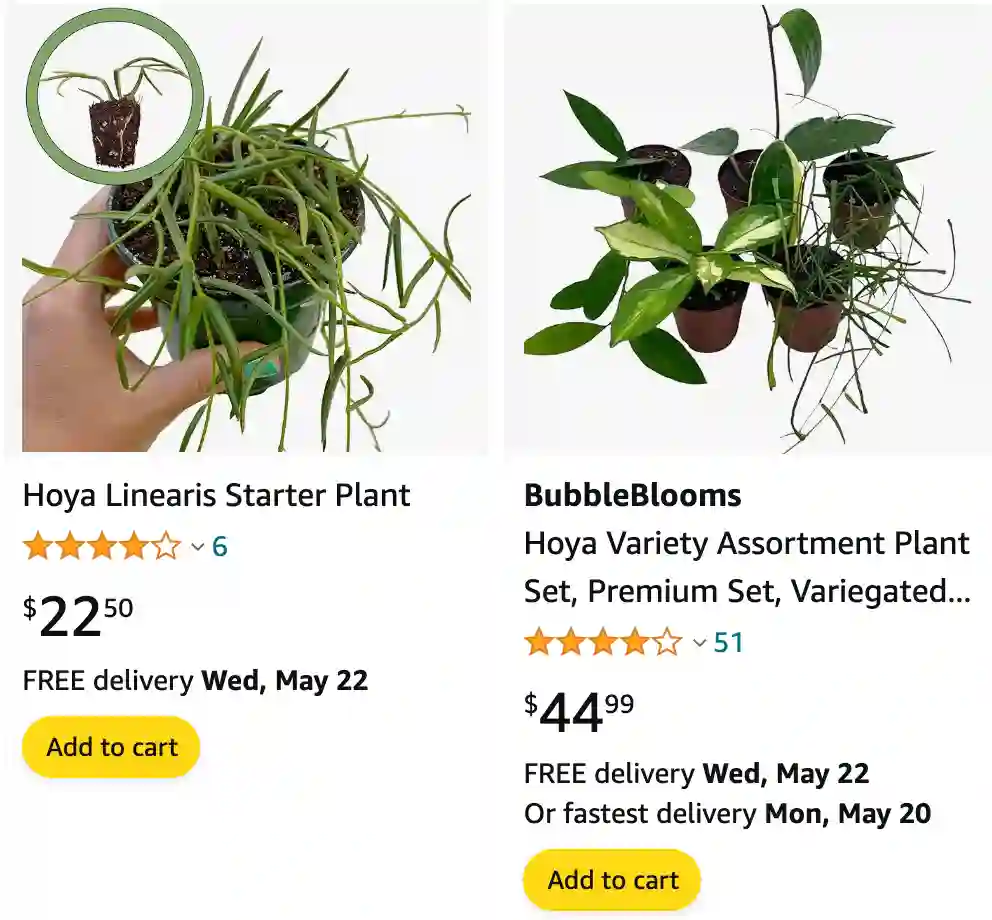
Hoya Linearis vs Retusa
My Hoya Linearis is like a cascading waterfall of fuzzy green beans. The leaves are plump and covered in soft hairs that make it a joy to brush my fingers against. It grows in a neat, orderly way, with the long, slender leaves draping down gracefully from the pot. In contrast, my Hoya Retusa is a bit of a wild child. Its leaves are flat and stick out in all directions, giving it a delightfully messy look. It reminds me more of a clump of playful grass clippings than a sophisticated vine. While both Hoyas are beautiful, the Linearis feels more delicate and the Retusa brings a touch of whimsy to my plant shelf.
Hoya Linearis vs Rhipsalis
My Hoya Linearis loves to climb. It readily wraps its long stems around any support I offer, creating a lush, cascading curtain of foliage. Watering it is a breeze – I just let the soil dry out slightly between soaks. Hoya Rhipsalis, on the other hand, is more of a hanging basket kind of plant. Its thin, segmented stems are reminiscent of a coral reef, with tiny, round leaves scattered along them. It almost feels like a wannabe air plant, preferring infrequent watering and bright, indirect light. While both are low-maintenance plants, the Hoya Linearis offers a more structured look, while the Rhipsalis adds a touch of the unexpected.
Hoya Linearis vs String of Needles
The Hoya Linearis is undeniably fuzzy and adorable. Its soft, needle-like leaves are a constant source of amusement, and it thrives in a spot with dappled sunlight. But when it comes to sheer vibrancy, my String of Needles takes the crown. The plump, bright green leaves practically glow in the sunlight, and it seems to grow like crazy with a little extra TLC. While both plants have cascading growth habits, the String of Needles tolerates more direct sun, making it a great choice for a sunny windowsill. The Hoya Linearis, with its fuzzy charm, prefers a more sheltered position.
How to care for hoya linearis?
Caring for my Hoya linearis involves a few key steps to ensure it stays healthy and thriving. Here’s how I manage it:
- Light: I place my Hoya linearis in bright, indirect light. It loves a lot of light but can get scorched by direct sun, especially during the hottest part of the day. A spot near a window with filtered sunlight works perfectly.
- Watering: I water my plant when the top inch of the soil feels dry. During the growing season (spring and summer), I water more frequently, but in the fall and winter, I reduce the watering schedule. It’s crucial not to let the plant sit in water to avoid root rot, so I ensure the pot has good drainage.
- Humidity: Hoya linearis enjoys higher humidity levels. I mist the plant occasionally or use a humidity tray filled with water and pebbles. In drier climates, a humidifier can also help maintain the desired humidity level.
- Soil: I use a well-draining soil mix to prevent water from sitting around the roots. A mix of orchid bark, perlite, and peat moss or a commercial cactus mix amended with extra perlite works well.
- Fertilizing: During the growing season, I feed my Hoya linearis with a balanced, water-soluble fertilizer every four weeks. I dilute the fertilizer to half the recommended strength to avoid overfeeding. I stop fertilizing in the fall and winter when the plant’s growth slows down.
- Pruning and Training: I trim back any leggy or dead vines to encourage bushier growth. Hoya linearis can also be trained to climb a small trellis or allowed to hang, showcasing its beautiful, trailing vines.
- Pest Control: I keep an eye out for common pests like spider mites, mealybugs, and aphids. Regularly wiping the leaves with a damp cloth helps keep pests at bay, and I use insecticidal soap if I notice an infestation.
- Temperature: Hoya linearis prefers temperatures between 60-80°F (15-27°C). I keep it away from cold drafts and sudden temperature changes, which can stress the plant.
By following these care tips, my Hoya linearis stays healthy and continues to produce its lovely, cascading vines.
How to propagate hoya linearis?
To propagate my Hoya linearis, I take stem cuttings that are about 4-6 inches long, making sure each cutting has several leaves and at least two nodes. After cutting, I let the ends dry out for a few hours to prevent rot. I then place the cuttings either in water or directly into a well-draining soil mix. If I use water, I change it regularly to keep it fresh. In soil, I keep the cuttings moist but not waterlogged. Within a few weeks, roots usually start to form.
Is hoya linearis fast growing? How fast does hoya linearis grow?
While not particularly fast-growing, Hoya linearis is not slow either. It tends to have a steady growth rate, putting out new vines and leaves gradually. I find that it grows faster during the warmer months when it gets plenty of light and humidity.
When does hoya linearis flower?
I bought my Hoya linearis from an online specialty plant shop, but they can also be found at local nurseries, garden centers, and even on plant enthusiast forums or social media marketplaces. It might take a bit of searching to find a healthy specimen, but checking with local plant shops or reputable online sellers can yield good results.




